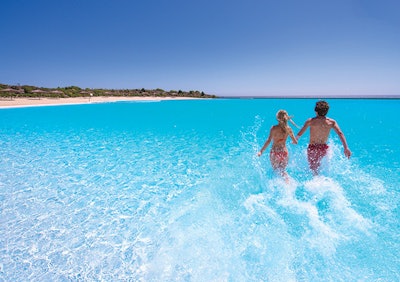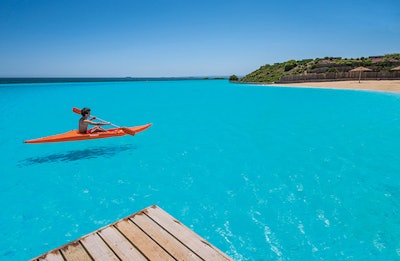
They are both big and beautiful. The vessels created by Crystal Lagoons have achieved widespread international recognition for not only their gargantuan size and strikingly clear water, but also for their ability to generate elevated real estate value for the properties that surround them.
Developed by Chilean scientist, innovator and entrepreneur Fernando Fischmann, the lagoons — which are not technically referred to as "swimming pools" — currently number 50 worldwide, largely in Latin American and the Middle East. The company reports there are currently 600 more in various stages of development in 60 countries, including the U.S.
Fischmann founded the company based in Santiago, Chile, nine years ago, after a period of extensive research and development based on his background in biochemistry and water treatment technologies. He reportedly holds more than 2,000 patents in 190 countries.
The lagoons first rose to prominence when an installation in Chile was declared the world's biggest swimming pool by Guinness World Records.

BIG SPLASHES
And make no mistake, the project was big! It included a 20-acre surface area with a volume of 250,000 m3 (66 million gallons), equivalent to 6,000 Olympic-sized pools. Images of the sprawling body of turquoise-blue water soon went viral and Fischmann's company quickly became well known for its pioneering efforts and far-flung ambitions.
RELATED: How Big is the Largest Pool in the World?
The company promoted the lagoons as "the world's best amenity," offering a beach lifestyle without the drawbacks of ocean water, instantly turning its locality into a magnet for development and tourism.
In many respects, the lagoons certainly look like massive resort swimming pools, with their white interior surfaces and well-defined architectural edges, swim-up bars and manicured beaches. Yet because of their size, they can accommodate small sailboats, kayaks, large waterparks and island structures. Subsequent installations proved Fischmann's concept viable, and the massive bodies of pristine-looking water fueled local real estate values as well as tourism and prestige for the properties and communities that invested in them.
In 2014, the company began focusing on the U.S. market. Earlier this year, the first-ever Crystal Lagoon in the U.S. opened in a residential development in Wesley Chapel, Fla. (Three more are scheduled for completion this year with eight more on U.S. soil currently in development.)
HOW DO THEY WORK?
For people in the pool and spa industry — a business whose sole purpose is to provide clean recreational water in quantities that might range from 500 to 50,000 gallons — the immediate and compelling question is: How can Crystal Lagoons deliver clean recreational water by the millions of gallons?
While images of Crystal Lagoons depict beautiful clear-water scenes, exactly how they function is far less clear than the water. Despite repeated inquiries from AQUA, the company refused to provide specifics beyond the generalities in its corporate literature.
As the Crystal Lagoons website reads:
"The Crystal Lagoons patented solution is to apply controlled pulses of very small quantities of oxidants/micro-biocides to the water in the lagoon, according to the growth cycles of algae and bacteria, in very specific patterns based on algorithms. In so doing, it is not necessary to maintain a high and permanent level of disinfection. The results of this efficient system are that it enables up to 100 times less additives to be used than are used in conventional swimming pool and drinking water treatment, all of which reduces excessive expense on chemicals and further environmental damage."
They go on to explain: "The application of additives is coordinated by strategically located injectors and sensors. This operation is managed by the Crystal Lagoons Control Center through the internet, so it is not necessary to have skilled people on site to apply additives and monitor the water quality of the lagoon. Also, Crystal Lagoons has developed and patented a new technology that enables the creation of different zones within large water bodies, whereby these zones can meet different water quality standards in order to comply with specific regulatory requirements."
The company also uses ultrasound technology as part of a massive flocculation scheme — one of the key components in its ability to treat water without the volumes of chemicals that would be required using a traditional swimming pool treatment regimen. According to Crystal Lagoons:
"The Crystal Lagoons patented solution is to apply natural compounds and different ultrasonic waves to the water in the lagoon, which enable the contaminant particles to be agglomerated into larger particles that are later removed from the lagoon. This means that only a small portion of the total water volume needs to be filtered.
"Therefore, the efficient Crystal Lagoons filtration system consumes only 2 percent of the energy used by conventional swimming pool filtration systems. Also, as the filtered flow is up to 300 times lower than conventional systems, the whole filtration system is smaller, decreasing installation requirements in terms of pumps and filter sizes."
RELATED: Key Misunderstandings and Problems in Pool Water Chemistry (Part 1)
The construction technique for the massive vessels is also unknown. Although they reportedly do not utilize reinforced concrete as a cost-saving measure, the company does not specify whether the water is contained by a liner system, composite materials, earthen structure, vermiculite or by some other means. They do offer that the structures are supported by 6 to 12 inches of "competent sand."

PUBLIC RECORDS
Three months prior to this writing, AQUA contacted Crystal Lagoons with a list of questions about its treatment method, including the type of oxidizers used, how the chemicals are added and where, the filtration method and the type of structure. Although the company responded to some of the more general questions, they declined to elaborate on the more specific issues beyond what's available on their website.
Digging deeper for public documents describing the system led AQUA to U.S. Patent #7,820,055, issued Oct. 26, 2010. Although far from a detailed explanation of system function, the patent document does yield further clues as to how the lagoons are treated.
The patent avoids the terminology and restrictions of swimming pools, and instead promulgates the technology of building "lagoons," which it defines as large bodies of water greater than 15,000 cubic meters, a volume just shy of 4 million gallons. (Most of the existing lagoons are much, much larger.) The description goes on to paint a complex picture of combined technologies and chemical constituents, most of which individually are, in fact, common to pool and spa water treatment.
The patent describes the system as: "A process to implement and maintain water bodies larger than 15,000 m.sup.3 for recreational use, including lakes and artificial lagoons with desirable color, transparency and cleanness properties, wherein the process comprises: (a) providing a structure with skimmers able to contain a large water body larger than 15,000 m.sup.3; (b) feeding the structure of step (a) with inlet water having iron and manganese levels lower than 1.5 ppm and turbidity lower than 5 NTU; (c) measuring water pH, wherein the pH is maintained no lower than 5 and no higher than 9; (d) adding an oxidizing agent to the water body contained in the structure of step (a), to maintain an oxidation-reduction potential (ORP) of at least 600 mV in the water body using a pulse of at least 4 hours within a 48 hour cycle; (e) adding a flocculating agent in concentrations within 0.02 and 1 ppm over a time period no greater than 6 days to precipitate impurities in the water to the bottom of the structure of step (a); (f) cleaning the bottom of the structure of step (a) with a movable suction device to remove the precipitated impurities from the bottom of said structure, together with the additional flocculants; and (g) generating a displacement of surface water containing impurities and surface oils by means of injection of inlet water according to step (b), which generates said displacement in such as way to remove said surface water using said skimmers provided in the structure of step (a), which together with step (f) replaces filtration to remove suspended debris from the water body."

Although interpretation of that passage and the remainder of the patent text is largely a matter of professional conjecture, some elements are relatively apparent: specifically, the system relies largely on surface skimming, water replacement, flocculation and intensive vacuuming to maintain clarity. It uses a technical approach known as "pulse oxidation" to target areas within the lagoons requiring treatment, which reduces the volume of chemicals needed while maintaining an ORP level of 600 mV.
Subsequent passages in the patent describe using a variety of oxidizers including ozone, sodium or potassium persulfate, chlorine derivatives, hydrogen peroxide, bromine derivatives and oxidizers produced by "electro-chlorination." It also describes adding a residual of sodium bromide when pH rises above 7.8.
Again, how all of those elements work together is not defined in the patent and is fiercely guarded by the company.
A REMARKABLE ACHIEVEMENT
It's important to note that AQUA found no indication of any problems associated with the lagoons. They are, by all accounts, an extraordinary story of success and growth, and that fact is to some extent a validation of their water treatment system.
RELATED: Pools: A History of Innovation - Part II
Now that Crystal Lagoons are appearing in the U.S., it is likely that some of the questions raised by these installations will be answered over time. For now, it's difficult or even impossible to know for sure how much water they use, the sustainability of the water quality, what happens in the event of an algae bloom or significant water quality issues or what chemical by-products may result from the treatment process, among other basic questions.
We do know that developers have embraced the lagoons and are seemingly clamoring to include them in their properties. Looking ahead, it's easy to imagine Crystal Lagoons will almost certainly continue to break records for size and be the object of beautiful photography.
How long the air of mystery about the Lagoon's water treatment methods will persist is anyone's guess.
Comments or thoughts on this article? Please e-mail [email protected].












































